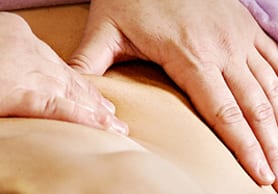Low back pain is perhaps the single most common complaint from our clients, and in my experience, the iliopsoas is almost always involved. It tends to become chronically contracted from injuries, extended sitting, and poor posture. The iliopsoas is antagonistic to the erector spinae, QL, and transversospinalis, and when it shortens, the extensors have to contract to counterbalance it. Since the extensor muscles tend to be weaker than the iliopsoas, they often blow out first, causing chronic low back pain.
Many well-intentioned massage therapists treat the painful back extensors, but ignore the root cause, which can be a shortened iliopsoas. Another challenge for bodyworkers is finding a comfortable and non-invasive way to release the iliopsoas. I’m personally fond of techniques that are easy to apply, relatively comfortable for clients, and provide fast and thorough results.
Another key muscle that’s often overlooked in bodywork is the diaphragm. The diaphragm is arguably the most fundamental muscle in our body, and certainly one that governs our life force. It is one of the first muscles we ever use, as well as one of the last. When the diaphragm is working properly, it massages the visceral organs with every breath. In my experience, the majority of our clients’ diaphragms are to some extent contracted and stuck, causing shortening and collapse of the chest, and upper and mid-back pain. Bodywork can powerfully assist in opening up the diaphragm, and clients often report that they have more lift and can breathe “twice as deeply with half the effort.” There are ways to safely and comfortably release the diaphragm that fit well into a standard table practice. How can a massage be called full-body if it doesn’t contact the diaphragm? 🙂
Contraction of the diaphragm also contributes to stasis and contraction of the visceral organs, and vice versa. In addition, when we are anxious or distressed, our natural instinct is to protect our belly and “stuff” emotions there, causing multilayered problems throughout the body. The smooth muscles of the gut contract, pulling on the surrounding mesentery and fascia, causing not only gut pain, but back pain. The sensitivity and vulnerability of the belly is precisely why it is so receptive to safe, calming, and nourishing touch. We can soothe the enteric nervous system and the soft underbelly, sending waves of deep relaxation throughout the entire body. We can relax the smooth muscles of the intestines, which reduces pain, improves digestive function, and eases the fascial pull in the back and other areas of the body.


